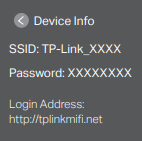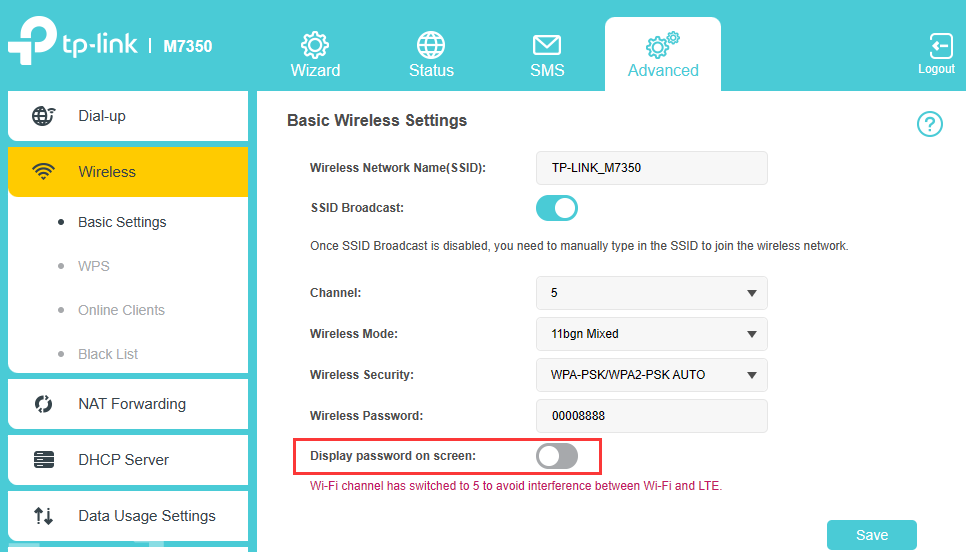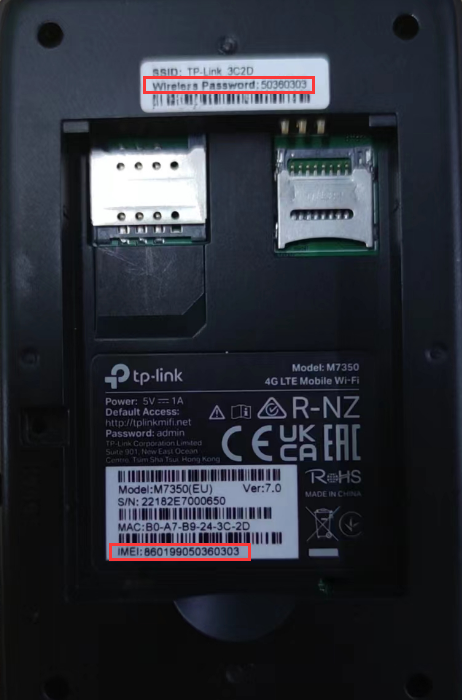如果我的TP-Link行動Wi-Fi產品標籤(標示預設無線密碼)遺失或損壞了怎麼辦?
M7000 , M7650 , M7350 , M7450 , M7010 , M7310 , M7200
Recent updates may have expanded access to feature(s) discussed in this FAQ. Visit your product's support page, select the correct hardware version for your device, and check either the Datasheet or the firmware section for the latest improvements added to your product. Please note that product availability varies by region, and certain models may not be available in your region.
TP-Link行動Wi-Fi設備(下文簡稱MiFi)上通常貼有兩張產品標籤,一張標有預設SSID和無線密碼,另一張標示為型號、硬體版本、MAC位址、IMEI等資訊。然而,MiFi使用一段時間後,標有預設SSID和無線密碼的標籤可能會遺失或損壞,因此無法識別預設密碼。
如果您遇到此類問題,且在恢復原廠設定後無法連接預設 Wi-Fi,請依照下列解決方案尋找目前的無線密碼。
解決方案1. 對於有螢幕的MiFi設備,例如M7350,M7450和M7650
若要查看SSID和密碼,請按MENU按鈕切換到裝置資訊圖示,然後按電源按鈕進入螢幕。

注意:若螢幕上沒有顯示密碼,則表示「螢幕上顯示密碼」功能已停用。

如果您現在仍然可以連接MiFi,您可以重新啟用它;
如果現在無法連接,請將MiFi設備恢復出廠設定:取下後蓋,用迴文針按住 RESET 孔約10秒,直到設備自動重啟,您將在螢幕上看到“正在恢復”,然後看到“成功”,即表示恢復出廠設定確實有效。
解決方案 2. 適用於所有 TP-Link MiFi 設備
TP-Link MiFi 裝置的預設無線密碼通常是 IMEI 的後 8 位數字,因此請在裝置內部的另一個標籤上尋找 IMEI,然後嘗試使用 IMEI 的後 8 位數字連線預設 WiFi。

解決方案 3. 對於支援 RNDIS 的 MiFi 設備
注意:目前 M7000 V1 不支援 RNDIS
請透過 USB 線將 Windows 電腦(Windows XP/Vista/7/8/10)連接到 MiFi 設備,然後透過http://tplinkmifi.net或http://192.168.0.1登入 MiFi 設備的 Web 介面,然後進入進階->無線->基本設定查找目前的無線密碼。
有關如何使用 RNDIS 功能的更多詳細信息,請參考如何使用 4G 行動 Wi-Fi 透過 USB 線訪問網路
這篇faq是否有用?
您的反饋將幫助我們改善網站
What’s your concern with this article?
- Dissatisfied with product
- Too Complicated
- Confusing Title
- Does not apply to me
- Too Vague
- 其他
謝謝
感謝您的反饋。
點擊此處與TP-Link技術支持聯繫。
Recommend Products
基本 Cookies
These cookies are necessary for the website to function and cannot be deactivated in your systems.
TP-Link
accepted_local_switcher, tp_privacy_base, tp_privacy_marketing, tp_smb-select-product_scence, tp_smb-select-product_scenceSimple, tp_smb-select-product_userChoice, tp_smb-select-product_userChoiceSimple, tp_smb-select-product_userInfo, tp_smb-select-product_userInfoSimple, tp_top-banner, tp_popup-bottom, tp_popup-center, tp_popup-right-middle, tp_popup-right-bottom, tp_productCategoryType
Livechat
__livechat, __lc2_cid, __lc2_cst, __lc_cid, __lc_cst, CASID
Youtube
id, VISITOR_INFO1_LIVE, LOGIN_INFO, SIDCC, SAPISID, APISID, SSID, SID, YSC, __Secure-1PSID, __Secure-1PAPISID, __Secure-1PSIDCC, __Secure-3PSID, __Secure-3PAPISID, __Secure-3PSIDCC, 1P_JAR, AEC, NID, OTZ
分析和行銷 Cookies
Analysis cookies enable us to analyze your activities on our website in order to improve and adapt the functionality of our website.
The marketing cookies can be set through our website by our advertising partners in order to create a profile of your interests and to show you relevant advertisements on other websites.
Google Analytics & Google Tag Manager
_gid, _ga_<container-id>, _ga, _gat_gtag_<container-id>
Google Ads & DoubleClick
test_cookie, _gcl_au
Meta Pixel
_fbp
Crazy Egg
cebsp_, _ce.s, _ce.clock_data, _ce.clock_event, cebs
lidc, AnalyticsSyncHistory, UserMatchHistory, bcookie, li_sugr, ln_or
1.0_1494398383830f.jpg)

